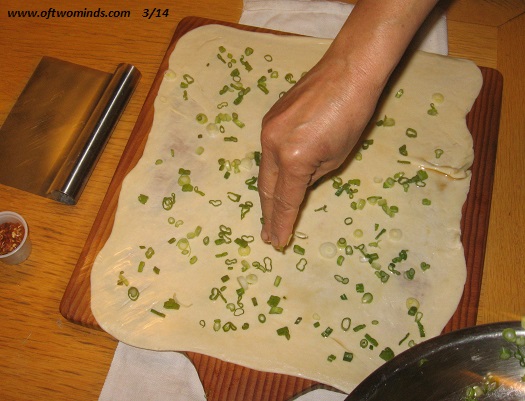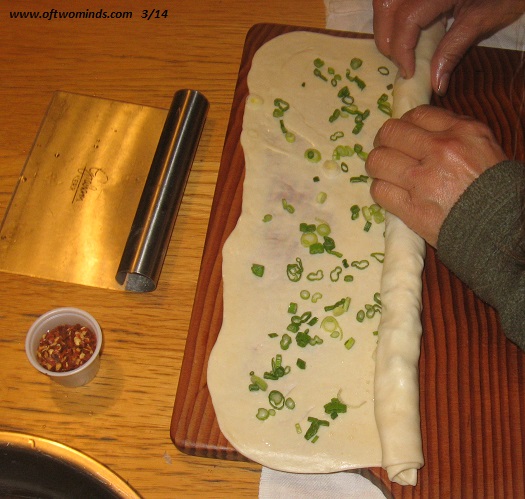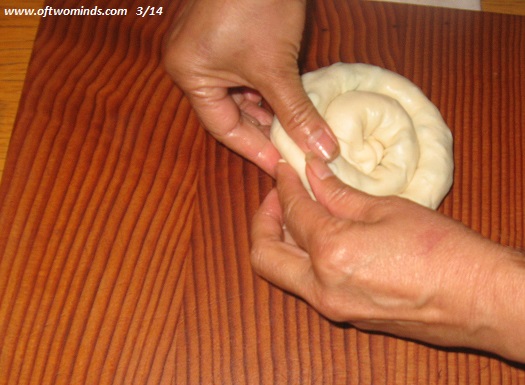What's Cooking at Our House: Chinese-Style Onion Flatbread
This pan-fried flatbread has a unique layered, chewy texture that is more like a savory bread than a pancake.
This scallion (green onion) flatbread is a popular street food in the less glitzy neighborhoods in China. We first tasted it in Shanghai in 2000.
This flatbread is also called scallion pancake, but pancake confuses two different Chinese recipes: one is a batter that is poured into a skillet (like conventional pancakes) while the other is a pizza-type dough that is rolled out and pan-fried.
This pan-fried flatbread has a unique layered, chewy texture that is more like a savory bread than a pancake.
Roll/stretch out the dough, smear with sesame oil, lightly salt to taste and generously sprinkle on the finely sliced green onions. Some people add a few pepper flakes for zest. (For context, this cutting board is about 13 inches square.)

Roll up the flattened square:

Crimp the seam and the ends of the roll:

Spiral the roll into a snail shape, and then crimp the end into the "snail."

Let the dough rest for 10 minutes, flour the board, press the spiral flat with the palm of your hand and then use a rolling pin to flatten the dough to skillet-size:

Lightly oil the skillet and cook the flatbread on both sides for about 3-5 minutes over medium heat. Slice into pieces and serve.

Well-known chef Martin Yang provides this recipe and video:
Cong You Bing (Scallion Pancakes)
Here's another recipe to review: we use much less salt than either of these recipes:
Pan-Fried Scallion Bread From Barbara Tropp's book The Modern Art of Chinese Cooking
While this may look a bit daunting to beginners (it certainly did to me), it's basically a pizza dough that is quick to mix and easy to roll out. Those who make their own pizza crusts will see this as a variation of flatbread that is pan-fried rather than baked.
The preparation of this flatbread lends itself to sharing the various tasks or cooking with kids. Each of the multiple steps teaches a basic skill that can be applied to other recipes, and the flatbread is forgiving and not finicky.
"A healthy homecooked family meal and a home garden are revolutionary acts."
The Nearly Free University and The Emerging Economy:
The Revolution in Higher Education
Reconnecting higher education, livelihoods and the economyWith the soaring cost of higher education, has the value a college degree been turned upside down? College tuition and fees are up 1000% since 1980. Half of all recent college graduates are jobless or underemployed, revealing a deep disconnect between higher education and the job market.
It is no surprise everyone is asking: Where is the return on investment? Is the assumption that higher education returns greater prosperity no longer true? And if this is the case, how does this impact you, your children and grandchildren?

We must thoroughly understand the twin revolutions now fundamentally changing our world: The true cost of higher education and an economy that seems to re-shape itself minute to minute.
The Nearly Free University and the Emerging Economy clearly describes the underlying dynamics at work - and, more importantly, lays out a new low-cost model for higher education: how digital technology is enabling a revolution in higher education that dramatically lowers costs while expanding the opportunities for students of all ages.
The Nearly Free University and the Emerging Economy provides clarity and optimism in a period of the greatest change our educational systems and society have seen, and offers everyone the tools needed to prosper in the Emerging Economy.
Read Chapter 1/Table of Contents
print ($20) Kindle ($9.95)
Things are falling apart--that is obvious. But why are they falling apart? The reasons are complex and global. Our economy and society have structural problems that cannot be solved by adding debt to debt. We are becoming poorer, not just from financial over-reach, but from fundamental forces that are not easy to identify. We will cover the five core reasons why things are falling apart:
 1. Debt and financialization
1. Debt and financialization2. Crony capitalism
3. Diminishing returns
4. Centralization
5. Technological, financial and demographic changes in our economy
Complex systems weakened by diminishing returns collapse under their own weight and are replaced by systems that are simpler, faster and affordable. If we cling to the old ways, our system will disintegrate. If we want sustainable prosperity rather than collapse, we must embrace a new model that is Decentralized, Adaptive, Transparent and Accountable (DATA).
We are not powerless. Once we accept responsibility, we become powerful.
Read the Introduction/Table of ContentsKindle: $9.95 print: $24
| Thank you, Jeff N. ($50), for your extraordinarily generous contribution to this site -- I am greatly honored by your steadfast support and readership. | Thank you, Steven C. ($5/month), for your exceptionally generous subscription to this site -- I am greatly honored by your support and readership. |



























